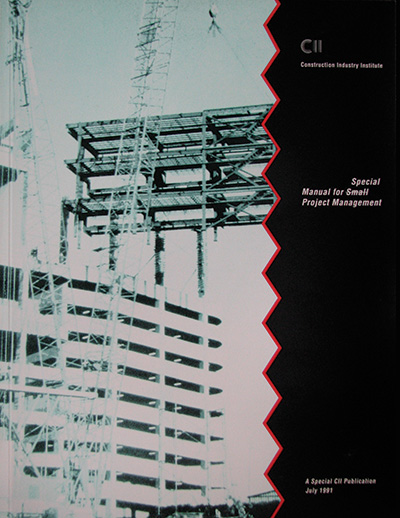
Manual for Small (Special) Project Management
This manual addresses the aspects of Project Management that are unique to Small or Special Projects and attempts to demonstrate how generally-accepted management techniques may be adapted to the Small Project. Those elements of Project Management that have been the subject of CII study and have had reports issued on them were given particular attention.
It is readily apparent that the elements of good project management apply to both large and small projects; innovation and thoughtful adaptation of available techniques are required to ensure Small Project success.
There are two extremely clear consensus conclusions arrived at by the Action Team:
- Due to the wide variations in relative size, complexity, schedule duration and cost of projects executed by an even less homogenous cross section of owners, architects, engineers and constructors, it is impossible to acceptably define what a Small Project is. If the project is felt to be small relative to the culture and available resources within an executing entity, then it is indeed a Small Project.
- The approach often taken to execution of a Small Project is nearly diametrically opposed to the approach that should be taken to insure its success. More often than not, Small Projects are used as training grounds for junior or less-experienced project management and execution staff. This is clearly inconsistent with the demands of the Small Project environment, where decisions must be made quickly; where the ability to recover from a bad decision is severely constrained by schedule duration, where the typical management support and control systems are not available or too cumbersome to be effective, and where individual initiative and judgment must be to some extent substituted for those control and support functions of the organizational hierarchy. Relatively more, rather than less, experience and capability is required of the Small Project team for efficient and quality execution of the work.
In compiling the Manual, the Action Team began with an attempt to identify the more significant problems that are unique to the Small Project; it then analyzed essentially all the key parameters of project execution.
Potential solutions were studied and are presented in the Manual, grouped into three general categories: the organizational structure, the planning phase, and the in-process management phase of the project. Additional and more detailed studies were conducted into other more specific elements of project execution, such as contracts and contract administration, project controls, and Total Quality Management. Revamp projects were given particular attention due to their archetypal Small Project nature and their own unique characteristics.
The environmental protection aspects of the project were addressed and a review of the more significant aspects of the project’s safety and health environment are included as well.

